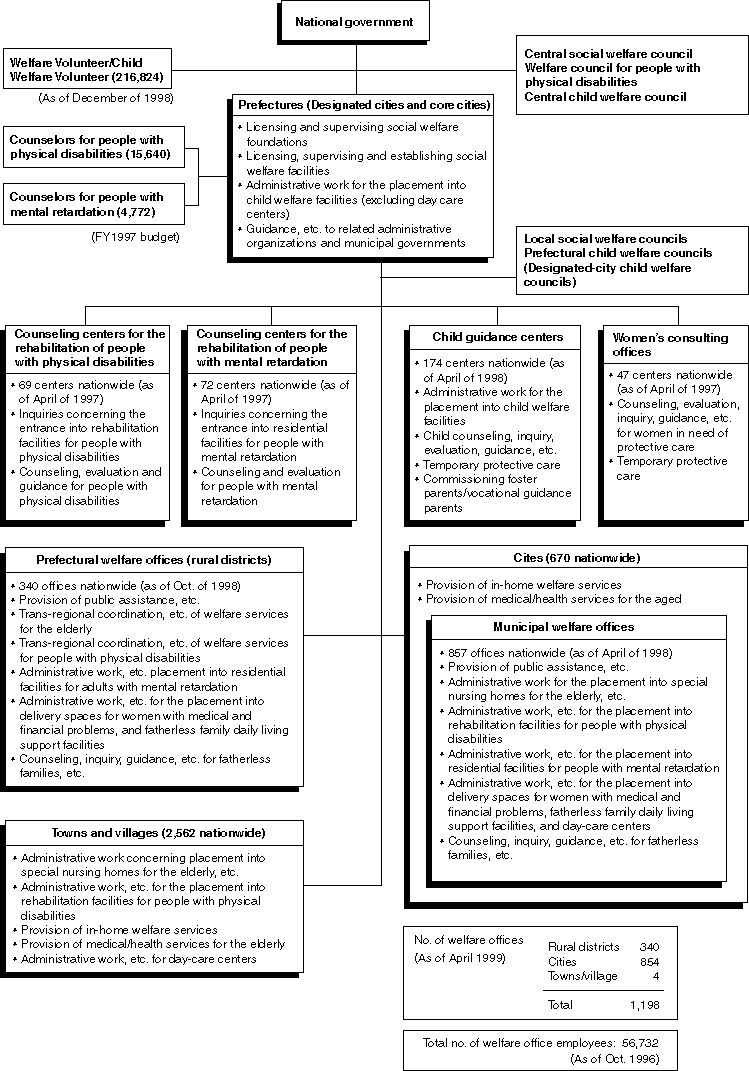
Overview

Overview
The Present Situation of Welfare Volunteers and Child Welfare Volunteers
Welfare volunteers are private volunteers commissioned by the Minister for Health and Welfare to conduct private voluntary welfare activities including:
1. Profiles of Welfare Volunteers and Child Welfare Volunteers

| 2. Work of Welfare Volunteer and Child Welfare Volunteer (FY1997) |
3. Contents of Counseling and Guidance by Welfare Volunteer and Child Welfare Volunteer (FY1997) |
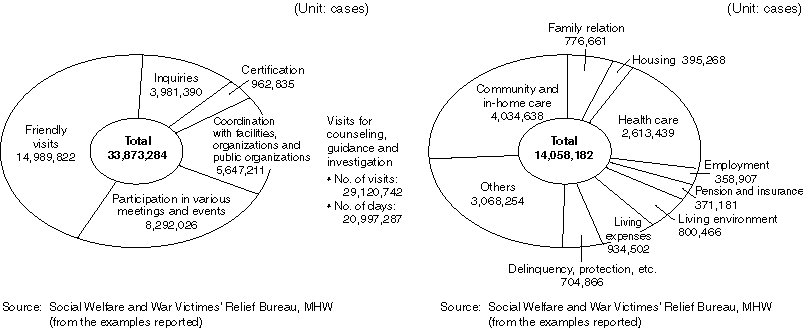
Overview
The Number of Volunteers
(As of April 1, 1998; Source: National Council of Social Welfare, Number of people and groups registered at the volunteer centers under the Councils of Social Welfare of prefectures, designated cities and municipalities)
Contents and Description of Activities
(As of March 1, 1996; Source: National Council of Social Welfare, "National Survey on the Actual Status of Volunteers" (for groups and organizations))



Overview
Social welfare foundations are juridical persons established under the Social Welfare Service Law for the purpose of conducting social welfare services (Category I and Category II social welfare services) prescribed in Article 2 of the Social Welfare Service Law.
Due to the public nature of social welfare services, regulation for the establishment and management of social welfare foundations are more strict than civil law-based public service corporations.
License for the establishment, etc. of a social welfare foundation is issued by the prefectural governor, the mayor of designated city/core city or, if its service encompasses two or more prefectures, by the Minister for Health and Welfare.
| Category I Social Welfare Services | Category II Social Welfare Services |
|
|
Requirements for the Establishment of a Social Welfare Foundation
In establishing a social welfare foundation, the following requirements must be met, in principle.
(The following is the main body extracted from "Concerning the Approval of Social Welfare Foundations (notification by the Director-General)" of 1964.)
|
1. Organization
The board members of a social welfare foundation should consist of directors numbering six or more (10 or more in case of a foundation without any trustees, managing residential institutions for welfare for the elderly/disabled people) and not exceeding 15, and two or more auditors. Among the directors should be people of knowledge and experience related to social welfare services, community representatives and the head of a facility managed by a social welfare foundation.
It is not appropriate to elect personnel from the related ministries and agencies and those who cannot participate in the actual management of the foundation in name only as a board member. Election of those who have familial relationships, etc. with board members is also limited.
Further, in cases where a facility, whose admission requirements are independent of the commissioning or placement order by the local public body governor, is to be developed, the facility must establish a council.
2. Assets
Basic property such as land and buildings which are needed to provide social welfare services should be prepared.
One-twelfth or more of the annual facility operation costs should be prepared as operating assets in cash, deposits, etc.
3. Services
A social welfare foundation is allowed to engage in public services and profit-making services in addition to the social welfare services listed on the previous page.
Public services are those services intended for public benefit but which do not fall into the category of social welfare services (Services which have no relation to social welfare are not approved.). Specifically, this refers to services which manage health service facilities, fee-charging homes for the elderly, etc.
Profit-making services refer to those services from which profit is appropriated to run social welfare service implemented by the foundation. Those services include the leasing management of buildings and parking lots, which are in the foundation's possession.
Both public and profit-making services should be handled subordinate to the delivery of social welfare services, the foundation's main services. In addition, the assets to be used for these purposes should be managed separately from basic and operating assets.
4. Others (1) Qualification for the head of a facility The head of a social welfare facility must meet the qualifications provided in the ordinance of the Ministry of Health and Welfare and "Concerning the Head of Social Welfare Facilities Managed by Social Welfare Foundations (notification by the Director-General)" in 1972. (2) Location The office of and the facility managed by the foundation should have the same address in principle. (3) Loans from social welfare and medical service corporations The term of loans from social welfare and medical service corporations, which are to be appropriated as the capital for facility construction, is within 20 years. Contributions from individuals should be used as a primary source.
5. Counseling on Establishment
In the course of establishing social welfare foundations, the owners should consult with the departments and bureaus of prefectures, designated cities/core cities in charge of the matter in charge of the matter (social welfare-related departments and bureaus such as Citizens' Living Department or Welfare Department). |
Changes in the Number of Social Welfare Foundations

Overview
Public Assistance System
The public assistance system is a system which provides necessary assistance to all people who are destitute in accordance with their level of needs. This system is intended to guarantee the minimum standards of a wholesome and cultured living and to enhance independence.
The system consists of seven kinds of aid: livelihood aid, education aid, housing aid, medical aid, maternity aid, occupational aid and funeral aid. One or more of these aid programs are offered according to the needs of each person in need of protection.

(Calculation of Income Appropriation Amount)
Average monthly income ? (actual necessary expenses + basic deductions) = income appropriation amount
(Calculation of Assistance Amount)
Minimum living expenses ? income appropriation amount = assistance amount
Standard Amount for Public Assistance
Among the standards for public assistance programs, the livelihood aid standard, which denotes the minimum standards for daily living for such items as food and clothing, is determined by a balanced maintenance method which is revised based on the growth of the consumption level of the general public.
Minimum Standards for Public Assistance by Type of Household (FY1999)
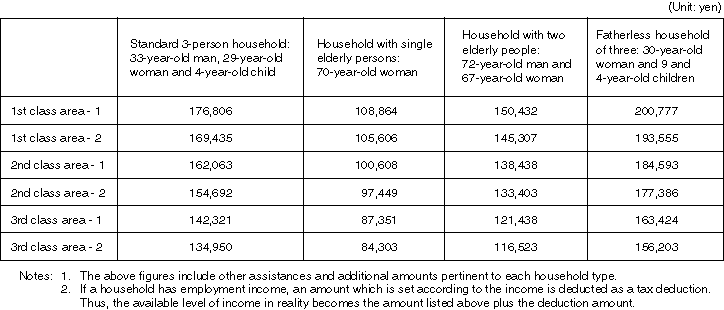
Changes in the Standard Amount of Livelihood Aid (monthly amount as of April 1 of each FY)
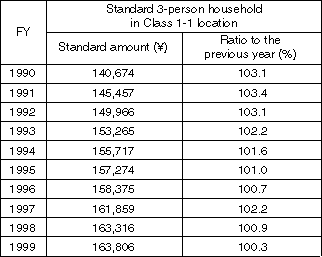
Detailed Data 1
Annual Changes in the Number of Households and the Population Receiving Public Assistance, the Assistance Rate, the Number of Aid Recipients and the Aid Rate
The most recent trend in public assistance shows slowed decrease since 1992, followed by the increase from the late 1996 both in the number of households and the population receiving public assistance. There were 905,589 recipients and 631,488 households in 1997 and the ratio of recipients was 7.2% per thousand.
By type of aid, medical aid recipients are increasing year by year.
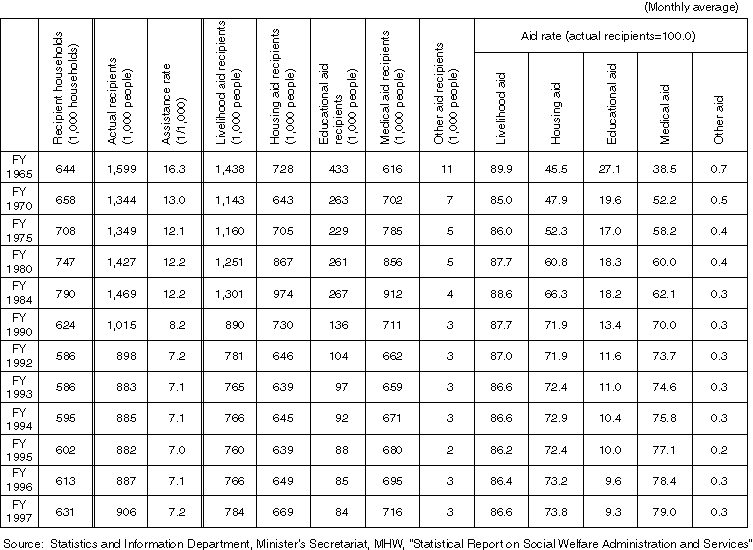
Detailed Data 2
Changes in the Proportion of Households Receiving Public Assistance by Household Type
With regard to the proportion of households receiving public assistance by household type, elderly households, fatherless households and households of people with diseases/injuries and disabilities account for about 90% of the total recipient households with their ratio increasing every year. In recent years, the ratio of elderly households have increased in particular, exceeding that of households of people with diseases/injuries and disabilities, which used to be the highest. In fiscal 1997, elderly households and households of people with diseases/injuries and disabilities accounted for 44.0% and 41.0%, respectively.
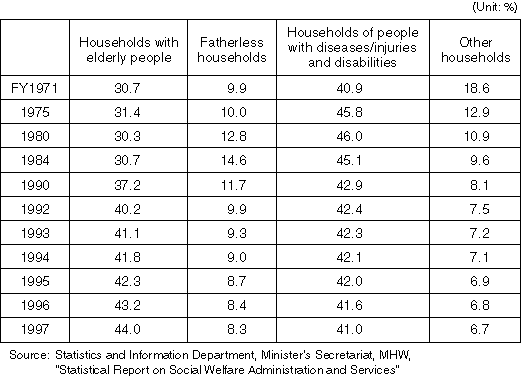
Overview
1. An Outline of Councils of Social Welfare (as of April 1, 1998)
|
1 council |
|
59 councils |
|
3,371 councils |
2. Some Major Projects Conducted by Municipal Councils of Social Welfare (actual status of FY1997)
(The numbers represent the ratio of municipal councils of social welfare which have implemented each
project: %)
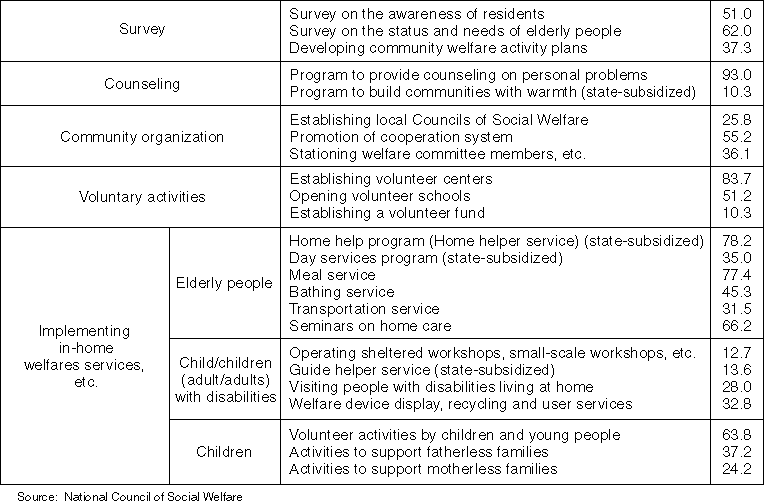
3. Councils of Social Welfare Offering In-Home Welfare Services (as of October 1, 1997)

Overview
An Overview of Consumers' Cooperative Societies
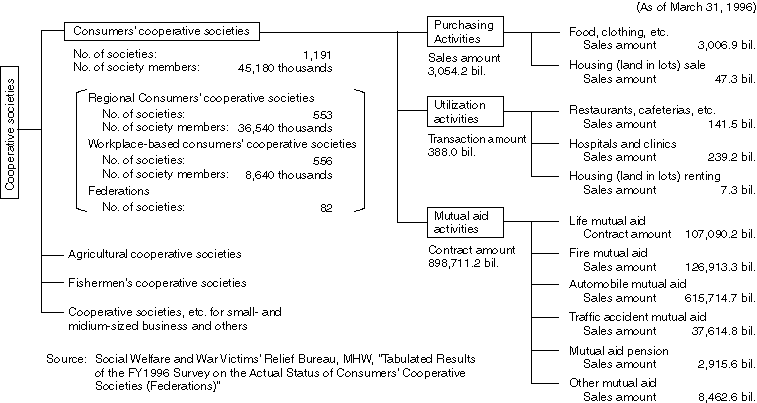
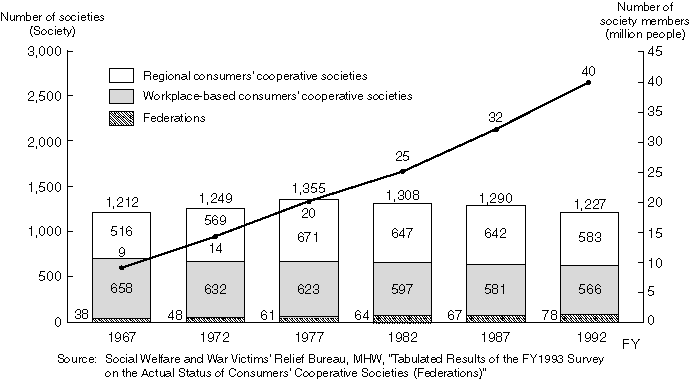
Detailed Data 1
The Status of Purchasing Consumers' Cooperative Society
(1) Number of Stores
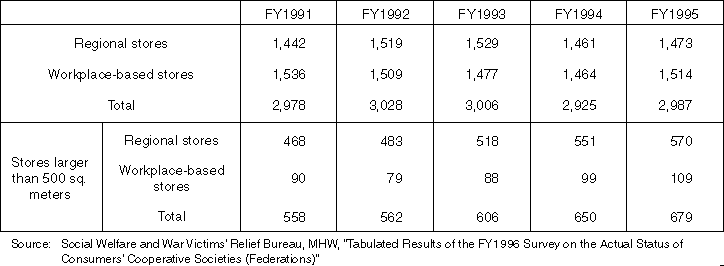
Detailed Data 2
The Status of Mutual Aid Consumers' Cooperative Society
(1) Changes in the Number of Cooperative Societies Offering Mutual Aid

(2) Changes in the Primary Mutual Aid Activities

Overview
The purpose of social welfare facilities is to care and nurture people with various types of handicaps in their social life, such as elderly people, children, people with mental and physical disabilities and the indigent, and to provide these people in need with various treatment and training for rehabilitation in order to improve their welfare.
Social welfare facilities can be roughly divided into welfare facilities for the elderly, rehabilitation facilities for people with physical disabilities, protective facilities, protective facilities for women, child welfare facilities, residential facility for adults with mental retardation and others.

Detailed Data 1
The Number and Capacity of Social Welfare Facilities by Facility Type
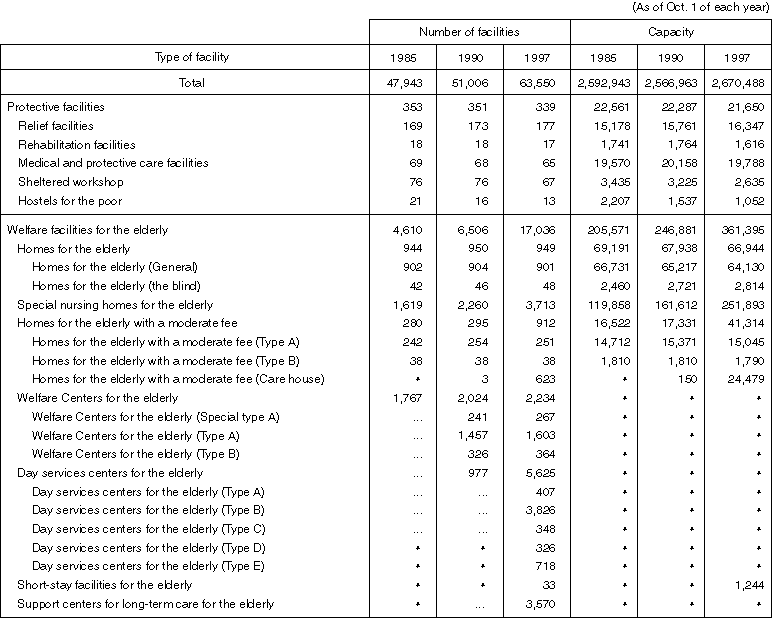
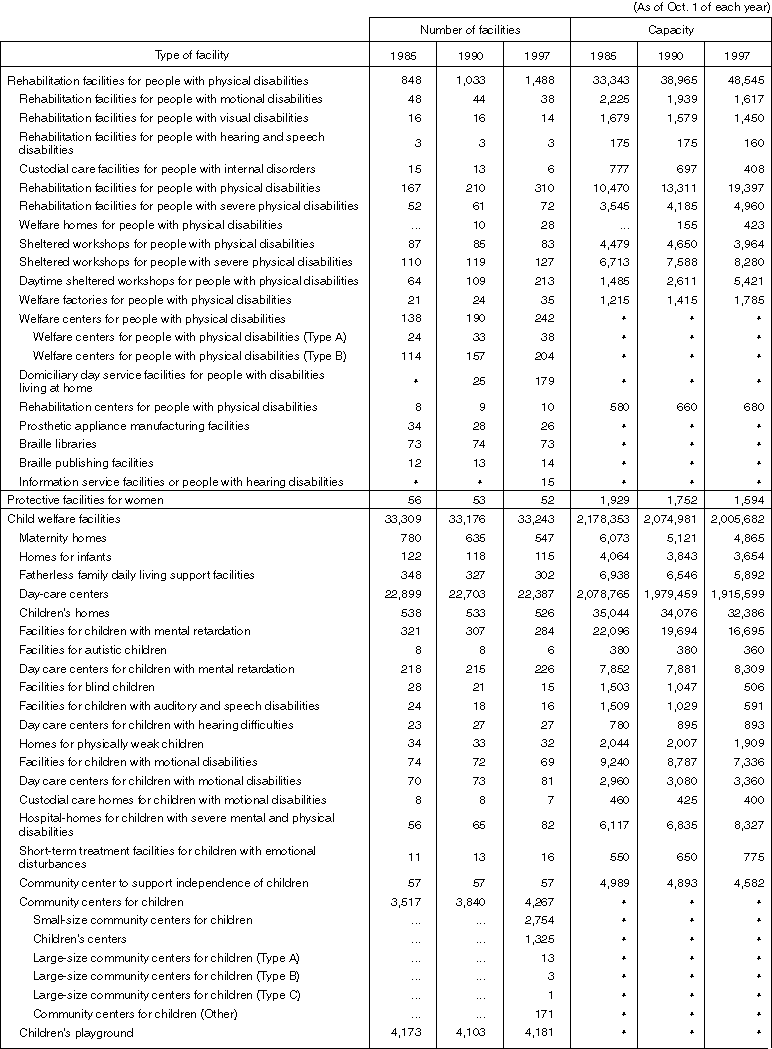
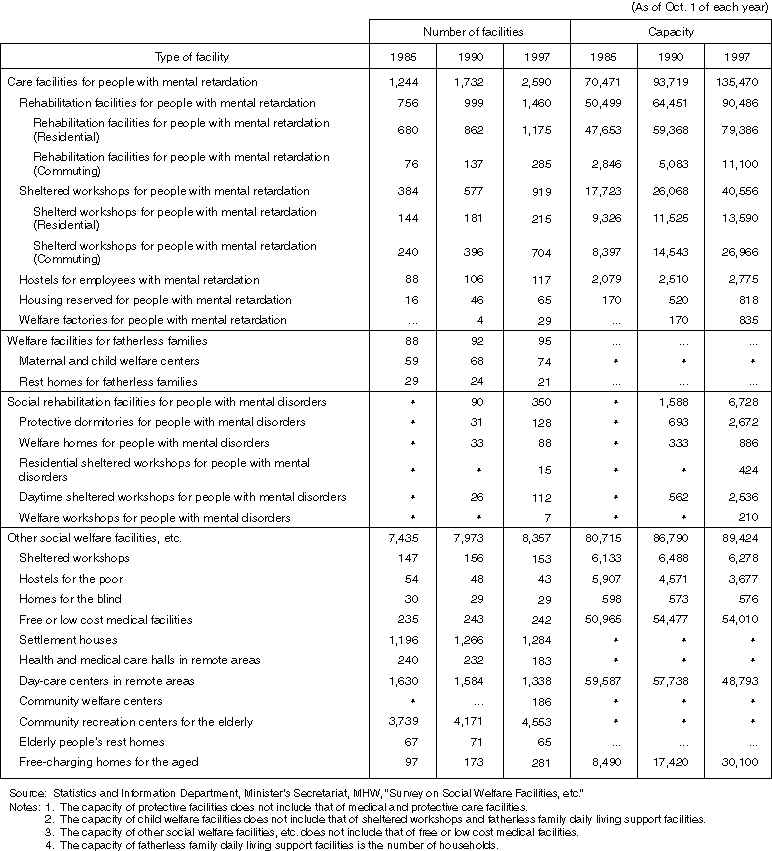
Overview
What are the Regional Welfare Right Protection Programs?
The programs aim at protecting the rights of the people with insufficient judgment, i.e. the senile elderly, persons with mental retardation, and persons with mental disorders, so that they can spend independent lives in communities, by encouraging them to make use of welfare services.
Structure
| (1)Qualification | People who are difficult to make use of diverse services with their own abilities due to insufficient judgment, i.e. the senile elderly, persons with mental retardation, and persons with mental disorders |
| (2)Description | "Life support staff" give assistance to welfare services indispensable to spend daily lives in communities for the service users pursuant to the service agreements concluded with them. (e.g. provision of information and advices,engaging in application procedures in behalf of the users,payment of welfare services fees, assistance for application of complaint solution system) |
| (3)Life support staff | Certified social workers, mental health and welfare workers, etc. |
| (4)Entity in charge | Prefectural Council of Social Welfare (a part of services are conducted by Municipal Council of Social Welfare.) |
Note: Scheduled to be implemented in October 1999
Overview
The cost of the development of social welfare facilities is paid by the public through national and local subsidies, special local bonds, loans from the Social Welfare and Medical Service Corporation and a part of the profits from public racing events as well as by a private aid system and by a loan system for the portion borne by each facility.
The table below shows the cost sharing relationship associated with the national subsidy for the cost of capital investment in the building (including equipment) of social welfare facility, in principle.

Cost for the operation of social welfare facilities (placement cost) is borne by those who have admitted people into the facilities or allowed the use of them or have commissioned a third party to do so, as described in the table next page.
In the case of a residential facility, if the people who are placed, or their family members responsible to support them, have financial ability to bear the cost, all or a part of the associated expenses, depending on that ability, will be collected from them.
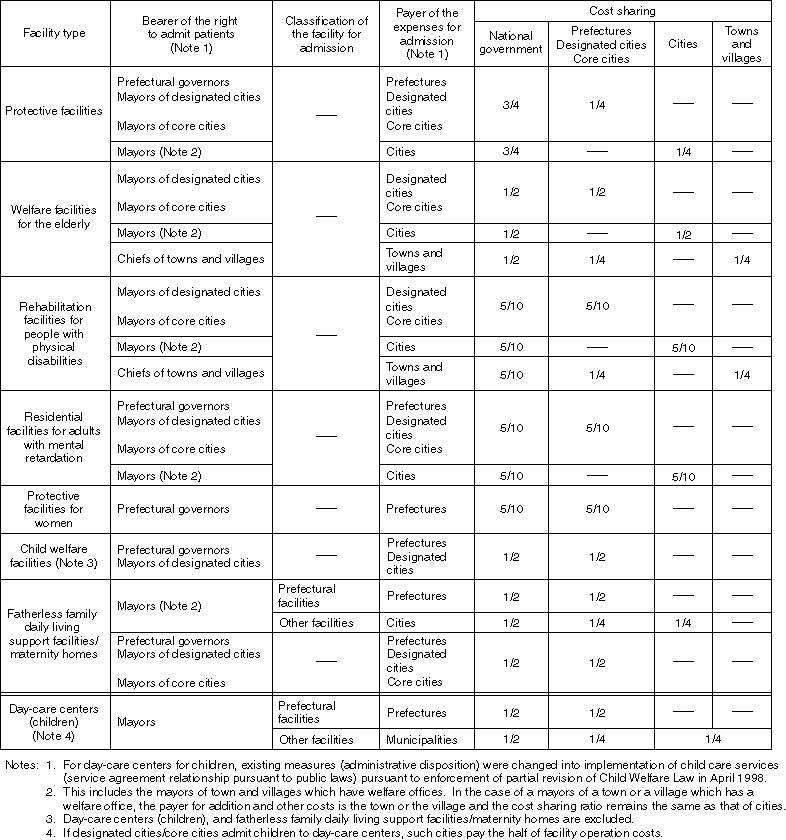
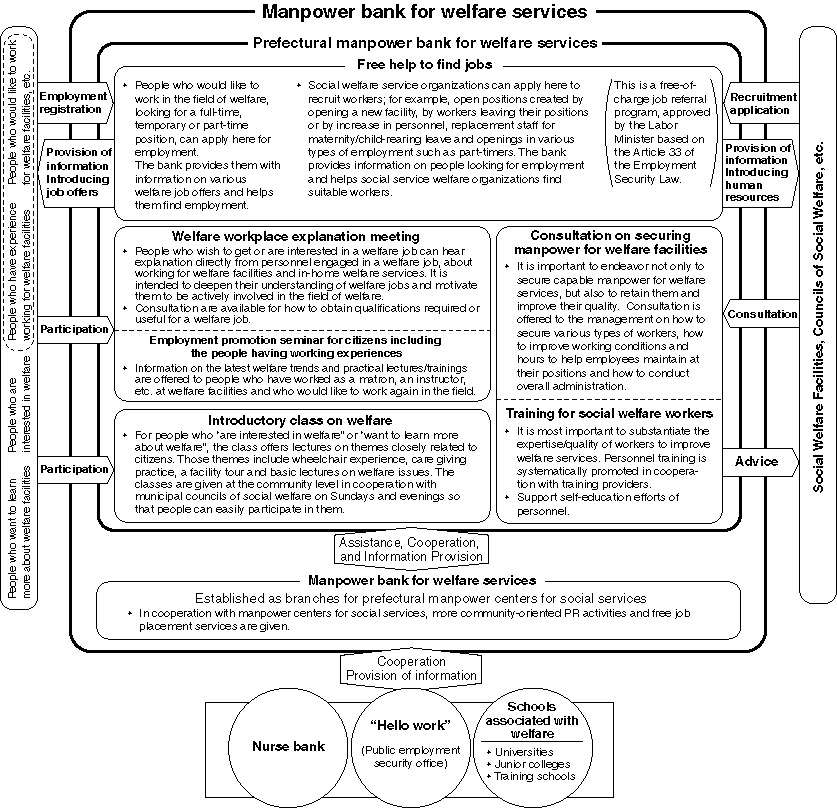
Detailed Data 1
Number of Social Welfare Facility Workers by Facility Type
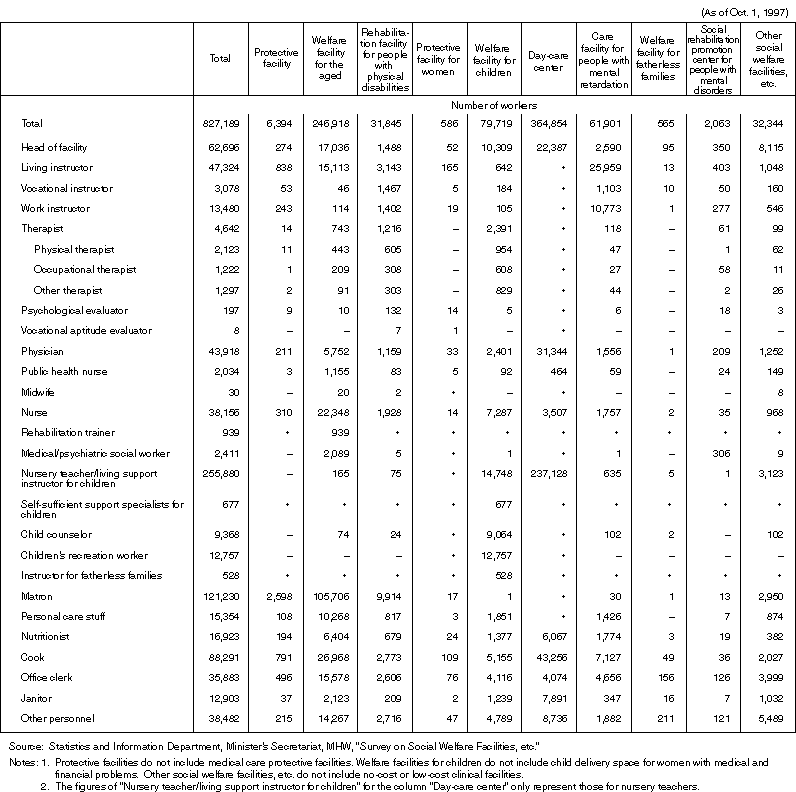
Overview
Certified Social Worker
A certified social worker is a person who provides, as his profession, consultation, advice, guidance and other forms of support according to his expertise to those who have difficulties in living their daily life due to their physical/mental disabilities or environmental reasons.
Those who have studied the subjects related to social welfare designated by the Minister for Health and Welfare in colleges and other institutions and those who have passed the State Examination for Certified Social Workers can become certified social workers upon registration.
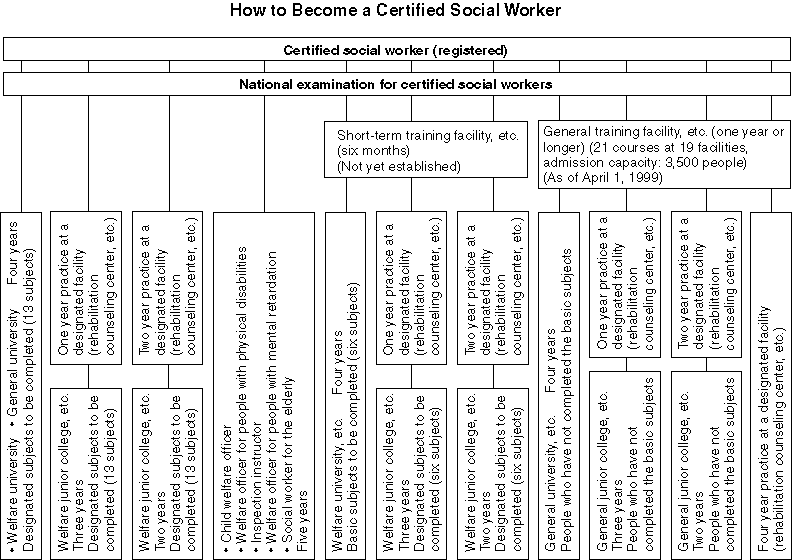
Certified Care Worker
A certified care worker is a person who provides, as his profession, personal care including assistance in bathing, going to the bathroom, meals and others and also provides care guidance to caregivers.
Those who have completed high school or higher education and those who have graduated from training schools designated by the Minister for Health and Welfare and, in addition, those who are engaged in personal care-related occupation for three years or longer can become certified care workers upon registration after passing the State Examination for Certified Care Workers.
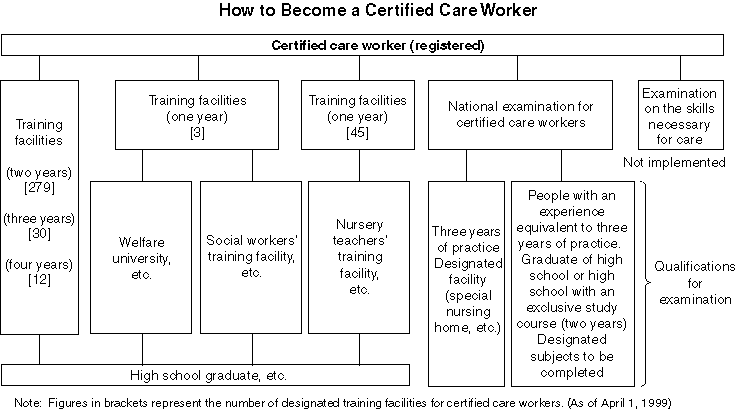
Detailed Data 1
Results of the State Examinations for Certified Social Workers and Certified Care Workers

Detailed Data 2
Numbers of Those Who Were Qualified as Certified Social Workers and Certified Care Workers in Each FY

Overview
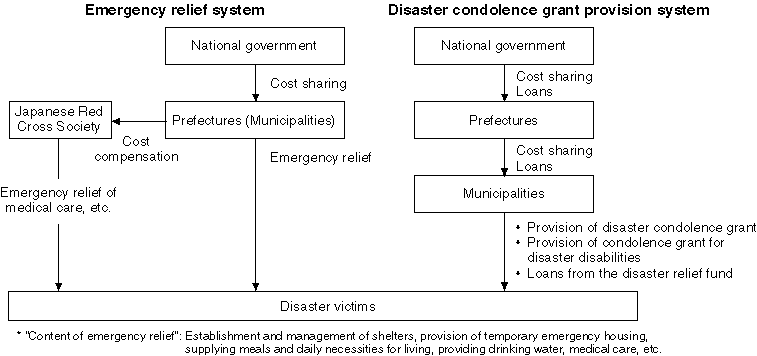
Disaster Relief Law
The Disaster Relief Law prescribes that, in cases where a disaster above a certain scale occurs, the national government shall provide emergency relief in cooperation with local public bodies, the Japanese Red Cross and other organizations and citizens, with the aim of protecting the victims and maintaining social order.
Provision of Disaster Condolence Grant, etc.
In addition to the provision of relief based on the Disaster Relief Law, the disaster condolence grant and the condolence grant for disaster disabilities are provided by municipalities and loans are made available from the disaster relief fund based on the Law Concerning the Provision of Disaster Condolence Grants, etc. for the victims of disasters above a certain scale.
Detailed Data 1
Application of the Disaster Relief Law

Detailed Data 2
The Disaster Damage of the Area Affected by the Disaster Relief Law in FY1998
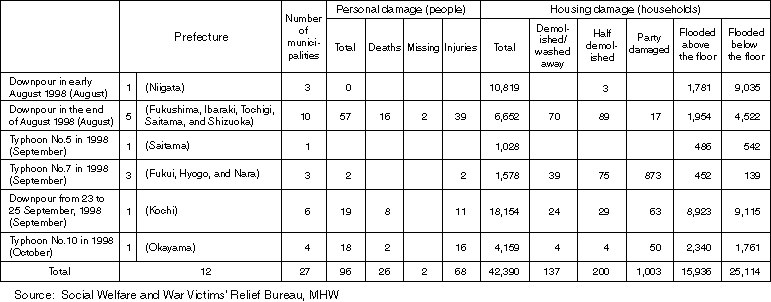
Detailed Information 1
List of Disaster Condolence Grants, etc.
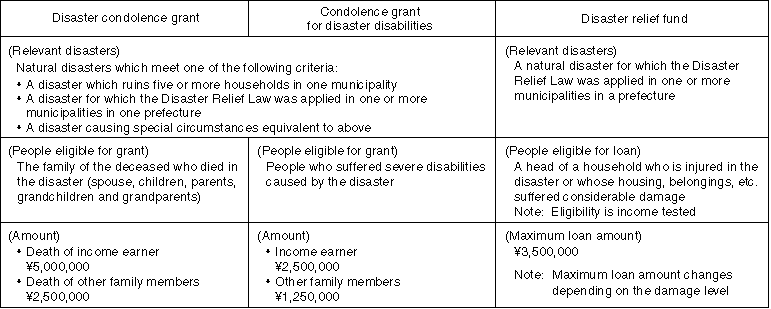
Overview
The Ministry of Health and Welfare is working to expedite the return of Japanese remaining in China after the war and to facilitate their smooth transition to life in Japanese society within the ultimate goal of self-sufficiency.
For Japanese orphans whose families have not been identified, the Ministry has conducted investigations to assist them in locating their family members through their group visits to Japan since March of 1981.
Situation of Japanese Remaining in China after the War as of March 31, 1999
| (1) | Total number of Japanese remaining in China | 932 |
| Japanese orphans | 425 | |
| Japanese women, etc. | 507 |
| (2) | The number of Japanese remaining in China who wish to | |
| return permanently to Japan (estimate) | Approx. 590 | |
| Japanese orphans | 260 | |
| Japanese women, etc. | 330 | |
Detailed Data 1
The Permanent Return of Japanese Who Remained in China after the War in Each FY
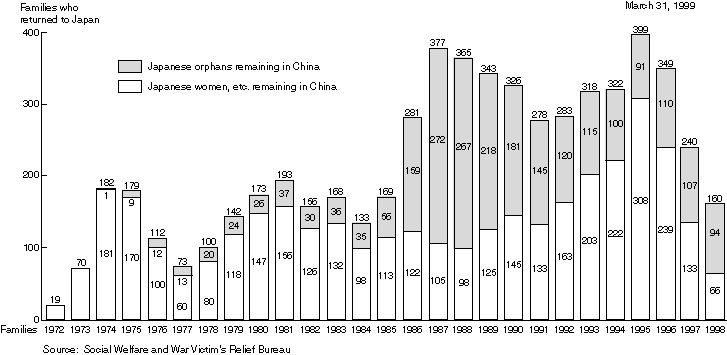
Detailed Data 2
The Temporary Return of Japanese Who Remained in China after the War in Each FY
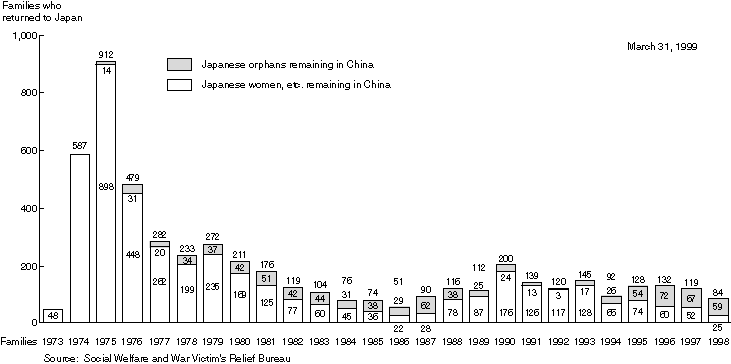
Overview
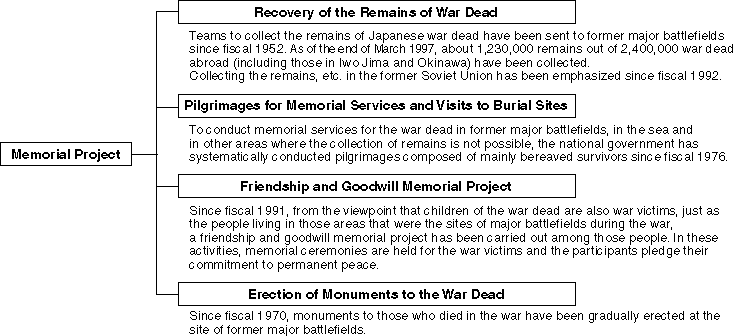
Detailed Data 1
Recovery of the Remains of War Dead Abroad
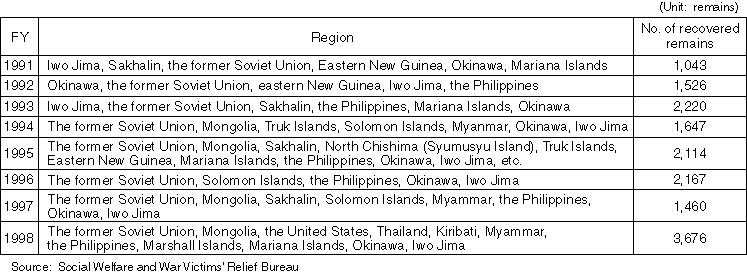
Detailed Data 2
Pilgrimages for Memorial Services and Visits to Burial Sites
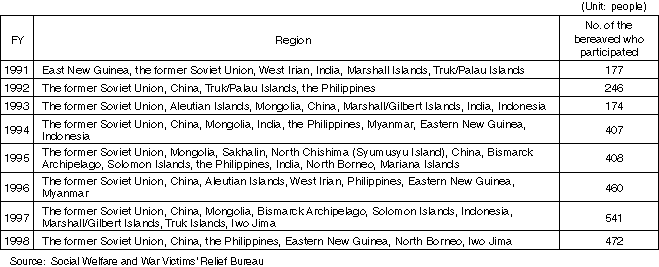
Detailed Data 3
Status of the Erection of Monuments to War Dead
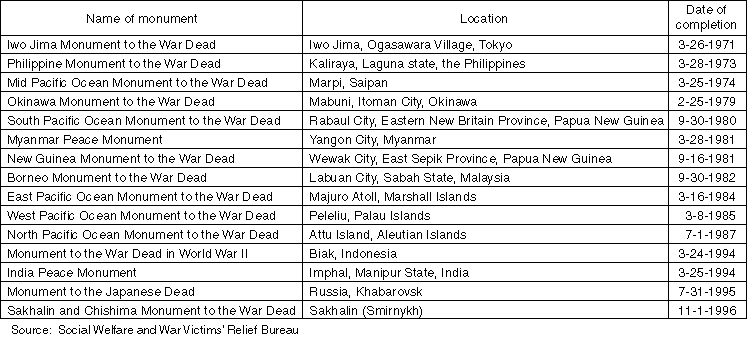
Overview
Relief in Accordance with the Law for the Relief of War Victims and Survivors
In connection with the injury, illness or death of military personnel, army civilian employees and paramilitary personnel, which was incurred in the line of duty, the national government provides them (excluding those receiving benefits on the basis of the Pension Law) or their bereaved survivors with pension benefits, etc. to assist them based on a spirit of state compensation.
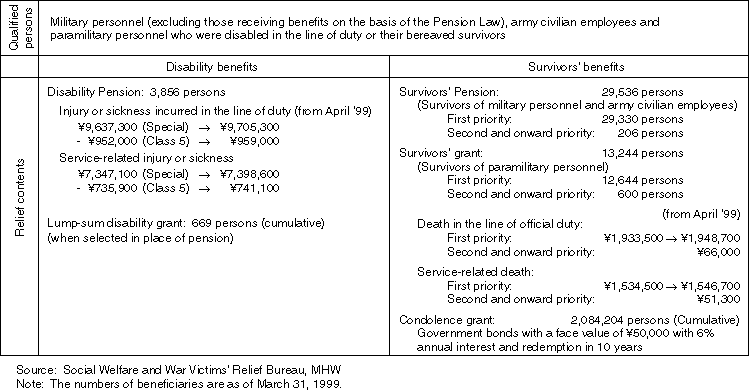
Relief in Accordance with the Law for Special Aid to the Wounded and Sick Retired Soldiers
In connection with the injury and illness of military personnel, army civilian employees and paramilitary personnel, which were incurred in the line of duty, the national government provides them with medical benefits, etc. to assist them based on a spirit of state compensation.
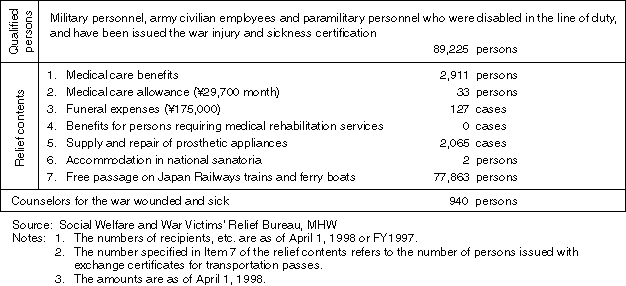
Detailed Information 1
Special Benefits, etc.
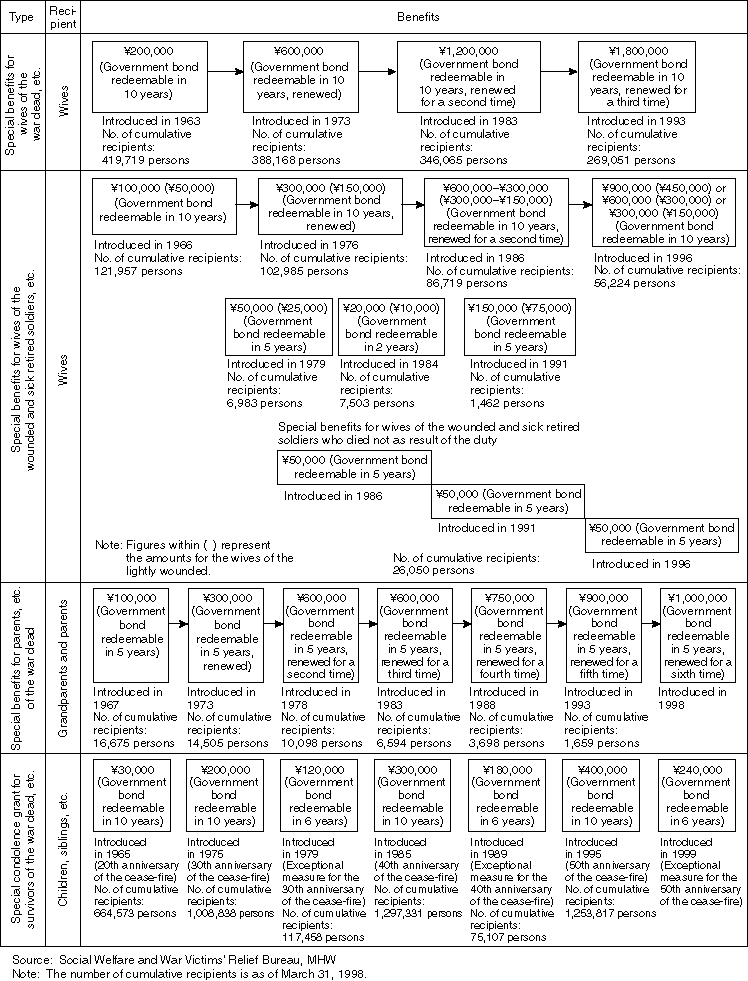
The national government provides government bonds as a special benefit to the wives, etc. of the war dead to console their mental pain and in recognition of the struggles they have undergone.
Additionally, the national government provides government bonds as special condolence to the bereaved on the occasion of 20th, 30th and 40th anniversary of the cease-fire to once again express its sympathy.